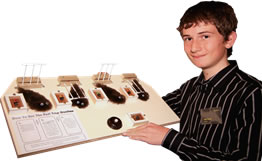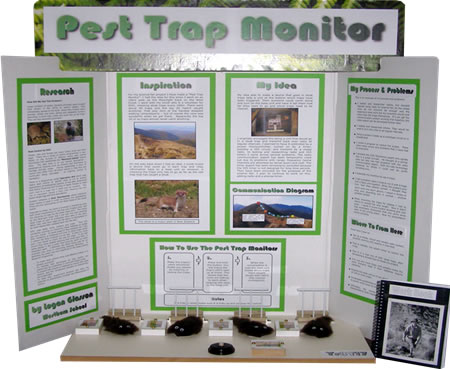Remote stoat trap monitor
 Logan Glasson
Logan Glasson
Westburn School, Christchurch
Year 8
Logan's uncle is a Department of Conservation (DOC) volunteer on the West Coast and one holiday Logan helped him clear stoat traps on the Moonlight track in the Paparoa Range. Traps were set every 100m on the 9km trapline but Logan found that no stoats had been caught on the top 2km of the line.
"It was a lot of walking for no reason – although the view was great," he says. "On the way down I thought: I must be able to invent something to go in each trap that communicated to a receiver at the bottom of the track whether it had caught a stoat or not."
Logan researched stoat trapping and talked to DOC staff about his idea. Their response was enthusiastic. Stoats kill 60% of all North Island brown kiwi born – that's 15,000 a year or 40 a day – and the population is halving every decade. Logan learnt that on some tracks, several hundred traps were sometimes used; it became apparent his idea would serve a real need.
Logan's idea of using a radio transmitter to signal the tripped/non-tripped status of the trap back to a base unit received a mixed response. While one DOC electronics expert Logan consulted cautioned that radio transmitters could be unreliable when used in dense wet bush, other DOC personnel pointed out that many important trapping areas are in open country, such as in Otago and the Mackenzie Basin.
Logan investigated the radio telemetry involved. He first experimented with his brother's set of walkie – talkies but found they had a very limited range. Other radio devices on the market were too expensive to use in the sort of numbers Logan had in mind. Logan plans to consult an electronics company about his requirements, but, in the interim, used wires to connect the different parts of his proof-of-concept model.
Logan identified the need for a timing system to turn on and off the transmitters when required, thus saving battery power. He experimented with a small commercial timer but found it inaccurate and unreliable. In his working model, Logan plans to use a low-power quartz crystal timer; in his development model, he used a simple push switch to turn on the monitors.
At the heart of each trap monitor is a PICAXE microcontroller. Logan created a program for it, using a breadboard (as an on-hand alternative to veroboard) to make some prototype circuits. "I wanted the PICAXE program to allow each unit to 'talk' to the next unit in sequence and relay the status of all of the traps to the bottom of the track."
Logan's father is a professional engineer and is "pretty useful" when it comes to programming, says Logan. "But "his eyes glazed over when I started trying to explain the logic of my PICAXE programming."
The most challenging aspect of the project has been troubleshooting the hardware and software. "At one stage I spent four hours fixing one glitch in the circuit. There were lots of bugs in the program as well," he says.
When he trialled the system using four traps and the monitor base unit, Logan found that when a trap stops transmitting it turned its PICAXE pin to 'low'. This both stopped it emitting and started it absorbing current, causing the output of the next trap to be 'swallowed' by its predecessors. Soldering diodes into place solved the problem.
The project is very much a 'work in progress', says Logan. Challenges yet to be overcome include:
- finding a reliable, low-power timer to control the chips;
- designing and building a durable housing for the monitors; and
- expanding the capability of the base unit so it can display the results of 100 or more traps.
He would also like to investigate the use of solar or wind energy to power the system.
Although much work remains, Logan has a very clear vision of how the finished product will operate. "In my dreams the system would work so well that DOC workers at their headquarters could know which traps had been activated using cellphone technology in the base station. It could even show on their computer screen. This would open up even more potential in the management of very remote places and islands."
It has been a neat project in which to be involved, says Logan. "I have learnt about electronics, PICAXEs, and New Zealand's pests. I have enjoyed making my pest trap monitors, and think it is great that by using my enjoyment of computer programming and electronics I could help New Zealand's native wildlife."
For his project Logan won the Best in Fair prize at the 2008 Canterbury Westland Regional Science Fair and as a result was nominated to attend the Genesis Energy "Realise the Dream" event organised by the Royal Society of New Zealand. He also gained second place in Category D (12 years and under) of the 2008 Bright Sparks Competition.
"The Realise the Dream event in Wellington was very good," says Logan. "We went to Media Training workshops at the Royal Society of NZ and visited various science-and-technology-related places around Wellington. I liked the carbon-dating trip to the National Isotope Centre. In a forensics session we looked at flies and maggots down microscopes, at Massey University, I used my own blood to work out blood type and see my red and white cells. We went to a very funny pantomime of Red Riding Hood and then had the biggest dessert I've ever seen at Strawberry Fare!
"I presented my project to a judging panel. The results will be announced at the prize-giving in March (2009), after they have seen our promotion folder as well. I highly recommend all students have a go at pursuing a project suitable for Realise the Dream. It was amazing. Before the event, I visited the DOC electronics expert and showed him my project, and he thought it was good. He also showed me what he does and some of the projects he is working on. It was very interesting and all the more so because it is actually helping and achieving something positive for New Zealand."






